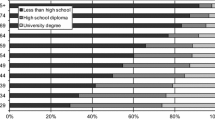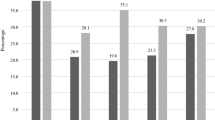Abstract
Since 1970 California has been the prime destination of the high numbers of both legal and illegal U.S. entrants. Fertility consequences have been dramatic. Births to U.S.-born women, after the decline in the 1970s and mild rebound in the 1980s, neared the 1970 level of 325,000. Yet total births rose from 360,000 to 600,000 in 1992. White non-Hispanic women bore nearly 70% of births in 1970 but 38% in 1992; Hispanic women, 20% in 1970 and 44% in 1992; others (primarily Asian ancestry), 3% and 10% respectively; and blacks, 9% and 7.5%. In the same period the proportion of births to U.S. natives fell from 89% to 56%; that to Mexican nationals rose from 7% to 27% (a six-fold increase absolutely); and that to women of all other birthplaces rose from 3% to 18%. Filipino women (the second largest category of foreign-born women) have borne 2% of all births since 1980. The increase in Mexican-born mothers was especially sharp after 1985, while the estimated Hispanic TFR rose 30% to 3.5 children per woman. In 1992 California's TFR was 2.42—18% above the U.S. average. In 1970 nearly 95% of teen mothers were U.S.-born, and 20% were Hispanic. In 1992, 61% of teen mothers were U.S. nationals; 60% were Hispanic, over half of them Mexican-born. The large increase in births in the 1980s, especially those to cultures supporting early childbearing, presages a sharp increase in births beginning in 2000. Meanwhile, the 5 years' median schooling of Mexican migrants has resulted in a parallel decline in parental education. Given the positive correlation of parental education and school achievement and attainment, California can expect a decline in the latter and hence lower labor productivity, incomes, and tax revenues by the young adults of the twenty-first century.
Similar content being viewed by others
REFERENCES
Bean, F.D., Swicegood, G. & Berg, R. R. (April, 1993). Family and fertility in the Mexican origin population of the United States. Report submitted to the National Institute for Child Health and Development.
Blau, F.D. (1992). The fertility of immigrant women: Evidence from high-fertility source countries. In G. Borjas and R. Freeman, (Eds.). Immigration and Workforce: Economic Consequences for the United States and Source Areas. Chicago: University of Chicago Press.
Borjas, G.J. & Tienda, M. (1993). The employment and wages of legalized immigrants. International Migration Review 27, 712-747.
Bouvier, L. (1991). Fifty million Californians? Washington, D.C: Center for Immigration Studies.
Chiswick, B.R. (1984). Illegal aliens in the United States labor market: Analysis of occupational attainment and earnings. International Migration Review 18, 714-732.
Chiswick, B.R. (1991). Speaking, reading, and earnings among low-skilled immigrants. Journal of Labor Economics 9, 149-170.
Connelly, R. & Gottschalk, P. (1995). The effect of cohort composition on human capital accumulation across generations. Journal of Labor Economics 13, 155-175.
Donato, K.M., Durand, J. & Massey, D.S. (1992). Stemming the tide? assessing the deterrent effects of the immigration reform and control act. Demography 29, 139-157.
Erickson, P.I. (1994). Lessons from a repeat pregnancy prevention program for hispanic teenage mothers in East Los Angeles. Family Planning Perspectives 26, 174-178.
Fix, M. & Passel, J.S. (1994). Immigration and immigrants: setting the record straight. Washington, D.C: The Urban Institute.
Ford, K. (1990). Duration of residence in the United States and the fertility of U.S. immigrants. International Migration Review 24, 34-68.
Forste, R. & Tienda, M. (1992). Race and ethnic variation in the schooling consequences of female adolescent sexual activity. Social Science Quarterly 73, 12-30.
Hernandez, D.J. with Myers, D.E. (1993). America's children: Resources from family, government, and the economy. New York: Russell Sage Foundation.
Instituto Nacional de Estadistica, Geografia e Informatica (1994). Encuesta nacional de la dinamica demografica, 1992: Principales resultados. Aguascalientes, Mexico.
Jasso, G. & Rosenzweig, M.R. (1990). The new chosen people: Immigrants in the United States. New York: Russell Sage Foundation.
Kahn, J.R. (1994). Immigrant and native fertility during the 1980s: Adaptation and expectations for the future. International Migration Review 28, 501-519.
Kalmuss, D.S. & Namerow, P. B. (1994). Subsequent childbearing among teenage mothers: The determinants of a closely spaced second birth. Family Planning Perspectives 26, 149-159.
Kossoudji, S.A. (1988). English language ability and the labor market opportunities of hispanic and East Asian immigrant men. Journal of Labor Economics 6, 205-228.
Kraft, J.M. & Coverdill, J.E. (1994). Employment and the use of birth control by sexually active single hispanic, black, and white women. Demography 31, 593-602.
Lapham, S. (n.d.) The foreign-born population in the United States: 1990. Washington, D.C: Population Division, U.S. Bureau of the Census. Document CPH-L-98.
Lieberson, S. (1980). A piece of the pie: Blacks and white immigrants since 1880. Berkeley: University of California Press.
Lieberson, S. & Waters, M.C. (1988). From many strands: Ethnic and racial groups in contemporary America. New York: Russell Sage Foundation.
National Education Association, Research Division (n.d.). Rankings of the states 1994. Washington, D.C.
Olsen, R.J. & Farkas, G. (1990). The effect of economic opportunity and family background on adolescent cohabitation and childbearing among low-income blacks. Journal of Labor Economics 8, 341-362.
Rong, X.L. & Grant, L. (1992). Ethnicity, generation, and school attainment of Asians, hispanics, and non-hispanic whites. The Sociological Quarterly 33, 625-636.
Rumbaut, R.G. (1994). The crucible within: Ethnic identity, self-esteem, and segmented assimilation among children of immigrants. International Migration Review 28, 748-794.
Schultz, F. (1994). California educational attainment vis-a-vis the U.S. in the 1990 census tables. Mimeo. Santa Barbara County: Administration Office.
Steinberg, J.B., Lyon, D.W. & Vaiana, M.E. 1992. Urban america: Policy choices for Los Angeles and the nation. Santa Monica, CA: Rand Corporation.
Stephen, E.H. & Bean, F.D. (1992). Assimilation, disruption and the fertility of Mexican-origin women in the United States. International Migration Review 26, 67-88.
Swicegood, G., Bean, F.D., Stephen, E.H. & Opitz, W. (1988). Language usage and fertility in the Mexican-origin population of the United States. Demography 25, 17-33.
Thom, L. (Winter 1994–95). Where are all of these poor people coming from? The Social Contract 5, 108-111.
United States Bureau of the Census (1993). The foreign-born population in the United States. 1990 census of population, CP-3-1. Washington, D.C: U.S. Government Printing Office.
United States Immigration and Naturalization Service (1992). Statistical yearbook of the immigration and naturalization service, 1991. Washington, D.C: U. S. Government Printing Office.
Ventura, S.J., Martin, J.A., Taffel, S.M., et al. (1994). Advance report of final natality statistics, 1992. Monthly Vital Statistics Report 43no. 5, suppl. Hyattsville, MD: National Center for Health Statistics.
Warren, R. (August, 1993). Estimates of the resident illegal alien population: October 1992. U.S. Immigration and Naturalization Service.
Author information
Authors and Affiliations
Rights and permissions
About this article
Cite this article
Burke, B.M. Trends and Compositional Changes in Fertility: California Circa 1970–1990. Population and Environment 19, 15–51 (1997). https://doi.org/10.1023/A:1024645531440
Issue Date:
DOI: https://doi.org/10.1023/A:1024645531440




